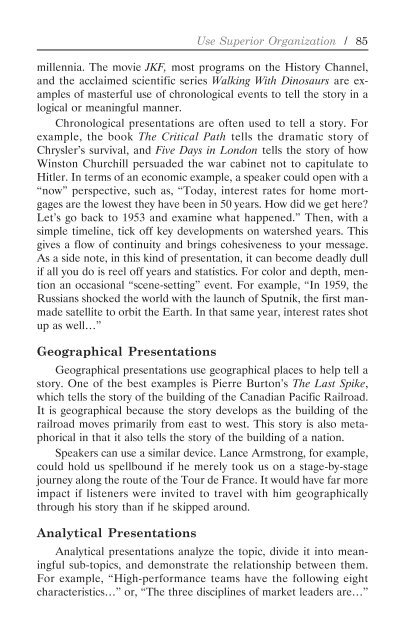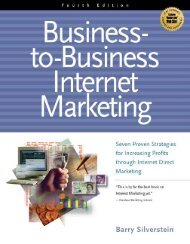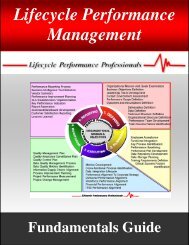The Seven Strategies of Master Presenters - Lifecycle Performance ...
The Seven Strategies of Master Presenters - Lifecycle Performance ...
The Seven Strategies of Master Presenters - Lifecycle Performance ...
You also want an ePaper? Increase the reach of your titles
YUMPU automatically turns print PDFs into web optimized ePapers that Google loves.
Use Superior Organization / 85<br />
millennia. <strong>The</strong> movie JKF, most programs on the History Channel,<br />
and the acclaimed scientific series Walking With Dinosaurs are examples<br />
<strong>of</strong> masterful use <strong>of</strong> chronological events to tell the story in a<br />
logical or meaningful manner.<br />
Chronological presentations are <strong>of</strong>ten used to tell a story. For<br />
example, the book <strong>The</strong> Critical Path tells the dramatic story <strong>of</strong><br />
Chrysler’s survival, and Five Days in London tells the story <strong>of</strong> how<br />
Winston Churchill persuaded the war cabinet not to capitulate to<br />
Hitler. In terms <strong>of</strong> an economic example, a speaker could open with a<br />
“now” perspective, such as, “Today, interest rates for home mortgages<br />
are the lowest they have been in 50 years. How did we get here?<br />
Let’s go back to 1953 and examine what happened.” <strong>The</strong>n, with a<br />
simple timeline, tick <strong>of</strong>f key developments on watershed years. This<br />
gives a flow <strong>of</strong> continuity and brings cohesiveness to your message.<br />
As a side note, in this kind <strong>of</strong> presentation, it can become deadly dull<br />
if all you do is reel <strong>of</strong>f years and statistics. For color and depth, mention<br />
an occasional “scene-setting” event. For example, “In 1959, the<br />
Russians shocked the world with the launch <strong>of</strong> Sputnik, the first manmade<br />
satellite to orbit the Earth. In that same year, interest rates shot<br />
up as well…”<br />
Geographical Presentations<br />
Geographical presentations use geographical places to help tell a<br />
story. One <strong>of</strong> the best examples is Pierre Burton’s <strong>The</strong> Last Spike,<br />
which tells the story <strong>of</strong> the building <strong>of</strong> the Canadian Pacific Railroad.<br />
It is geographical because the story develops as the building <strong>of</strong> the<br />
railroad moves primarily from east to west. This story is also metaphorical<br />
in that it also tells the story <strong>of</strong> the building <strong>of</strong> a nation.<br />
Speakers can use a similar device. Lance Armstrong, for example,<br />
could hold us spellbound if he merely took us on a stage-by-stage<br />
journey along the route <strong>of</strong> the Tour de France. It would have far more<br />
impact if listeners were invited to travel with him geographically<br />
through his story than if he skipped around.<br />
Analytical Presentations<br />
Analytical presentations analyze the topic, divide it into meaningful<br />
sub-topics, and demonstrate the relationship between them.<br />
For example, “High-performance teams have the following eight<br />
characteristics…” or, “<strong>The</strong> three disciplines <strong>of</strong> market leaders are…”










